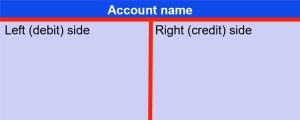2.1 Dual-entry accounting system and T-Accounts
Rina Dhillon
While transactional analysis (first introduced in Chapter 2 of the AAA textbook) is a great way to understand and visualise the effect of accounting transactions, in reality, accounting transactions are not recorded using pluses and minuses in a spreadsheet. The reason for this is that while this analysis can be very accurate and easy to do with a small number of transactions, it becomes very unmanageable when a business, especially large ones, can have hundreds of accounting transactions a day. In practice, accounting systems are based on a system of recording known as double-entry accounting or book-keeping.
The dual entry accounting system is based on the dual (two-sided) nature of accounting – that is every accounting transaction affects at least two accounts and thus the accounting system records every accounting transaction with a dual or double entry in the appropriate accounts. This universally used system, which are mostly now computerised, offers a logical method for recording business transactions. It also provides a means of ensuring the accuracy of the amounts recorded in the system through the use of T-accounts.
The T-Account
All accounts in the accounting system can be represented using a T-account. It is called a T-account because it resembles the letter T. In its simplest form, an account comprises of three parts: (1) the name of the account; (2) a left, or debit, side; and (3) a right, or credit, side. As shown in the T-account below, the left side records debit entries and the right side records credit entries:
 The left (debit) side and the right (credit) sides of each account are used for recording and accumulating the financial information from business transactions. T-account are useful to help analyse how individual transactions flow and accumulate within various accounts, be it assets, liabilities and owner’s equity, as well as revenues and expenses. In general, T-accounts work as follows. When a transaction affects an account balance, the financial amount of the transaction is entered on the account’s debit or credit side, depending on what the transaction relates to.
The left (debit) side and the right (credit) sides of each account are used for recording and accumulating the financial information from business transactions. T-account are useful to help analyse how individual transactions flow and accumulate within various accounts, be it assets, liabilities and owner’s equity, as well as revenues and expenses. In general, T-accounts work as follows. When a transaction affects an account balance, the financial amount of the transaction is entered on the account’s debit or credit side, depending on what the transaction relates to.
Once all transactions have been entered, the balance in an account is determined by individually adding up all the debits and all the credits, and subtracting the smaller total from the larger total. The difference between the large and small totals will determine the account balance and will be placed on the side of the T-account that is larger. Essentially, when the totals of both sides of a T-account are compared, an account will have a debit balance if the total of the debit amounts is more than the total of the credits. On the contrary, an account will have a credit balance if the total of the credit amounts is more than total of the debit amounts. The type of account determines whether an increase or a decrease in a particular transaction is represented by a debit or credit. Let us now look closely at what a debit and credit is and how they are used to record accounting transactions.